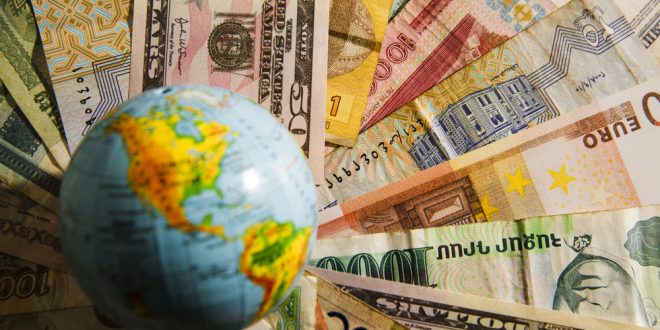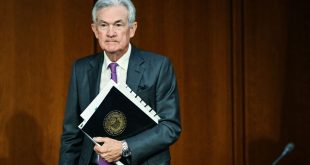The first interest rate cut in the USA is now expected in July 2024, pushed out from the June rate cut priced in before. The Fed’s updated economic outlook shows that the US economy has held up better than expected, with a modest cooling to 1.5% annual growth in 2024 and a rebound to 1.8% in 2025. The unemployment rate is expected to stay at 3.8% this year and no higher than 4.1% for the cycle, well below the 10-year average of 5.0% unemployment.
The Fed’s message is obvious
Fed’s message to markets is obvious as adopting higher for longer and fewer rate cuts in 2024. The Fed held its September meeting this past week, and the message from Jerome Powell was clear: indicating that it will continue to keep rates elevated until inflation moves more convincingly toward 2.0%.
The Fed held rates steady at 5.25% – 5.5%, but kept the option of an additional rate hike on the table, maintaining its outlook for a peak fed funds rate of 5.6%. The Fed’s new set of projections also reduced the number of potential rate cuts in 2024, from 1.0% to 0.5% of cuts next year, implying that the elevated interest-rate environment may last longer than expected.
The Fed’s update to the “dot plot” or the FOMC’s best estimate of where it sees the path of interest rates going shifted higher, with the median dot for 2023 remained at 5.6%, suggesting one more rate hike is on the table. Since last week’s meeting, markets now expect the Fed to remain largely on hold, although the probability of a December hike has increased.
Gold Performance
As a result of declining Treasury yields and the Fed’s decision on monetary policy, gold prices reached the $1946.06 high on Wednesday. However, after the FOMC decision on Thursday, prices fell to a low of $1915.36 on the same trading day. After reaching a weekly low of $1913.99, the precious metal later gained some ground, but it is still unable to overcome strong resistance at $1929.79.
Gold was last seen trading at $1925.23 per ounce. Factors like dropping US T-bond yields and the upbeat market sentiment drive the Gold Index (XAU/USD) towards the current spot at $1925.36.
XAU/USD prices are moving upwards on the reversal of US bond yields. The US 10-year benchmark note coupon reversed from a 16-year high of 4.51% towards 4.44%. Consequently, US real yields are edging lower from five basis points from 2.11% to 2.06%.
Fed officials obviously turned cautiously, led by Boston and San Francisco Fed Presidents Susan Collins and Mary Daly, stressing that although inflation is cooling and further rate hikes would be needed, the Fed must be patient. Fed Governor Michelle Bowman commented that more increases are needed to control inflation.
S&P Global released the final PMI readings for the US in terms of data. Though it increased to 48.9, the manufacturing PMI was still in recessionary zone. While the Services and Composite PMI expanded and still aimed for the 50 expansion/contraction mark, it also showed signs of losing steam.
Gold’s advance was halted while the US Dollar Index records slight gains of 0.17%. The DXY is at 105.56 and is expected to post strong gains for the tenth consecutive week. Consumer Confidence, Durable Goods Orders, Initial Jobless Claims, and the Fed’s favourite inflation indicator, core PCE, are all important indicators for the US.
Other Central Banks
The People’s Bank of China kept lending rates unchanged in September, as policymakers assessed the impact of measures taken previously, including an interest rate cut in August and a recent reduction in the percentage of mandatory reserve requirements for banks.
The Bank of England kept interest rates unchanged at 5.25% during its September meeting, keeping borrowing costs at their highest levels since 2008, as policymakers opted to wait and watch after recent data on inflation suggested the cumulative effects of previous policies may have… Its effects are beginning to appear.
The Bank of Japan kept its key short-term interest rate at -0.1% and 10-year bond yields around 0% at its September meeting by unanimous vote.
The Swiss National Bank unexpectedly kept its key interest rate steady at 1.75% at its September 2023 meeting, noting that significant monetary policy tightening over recent months is working to counter remaining inflationary pressures.
Bank of Canada
In Canada, the Bank of Canada also held rates steady at 5.0%, noting that deteriorating economic growth and a cooling job market were keeping rates on hold for now. However, the BoC kept the option open to increase rates again, particularly if inflation showed signs of moving higher.
The US and Canadian markets quickly reacted to this somewhat hawkish Fed outlook, with government bond yields moving sharply higher, putting downward pressure on stock and bond returns. Longer-duration parts of the market, including technology and growth sectors, underperformed the broader market.
Despite the economies in the US and Canada holding up, there are early signs of easing in consumption and the labour market. As summer travel season ends, consumers face an extended period of higher rates and tighter borrowing standards, oil prices are elevated, and excess savings post-pandemic have been largely drawn down.
Although the job market remains solid, some early warning signs, like fewer job openings and lower quits rates, have emerged. Markets have responded swiftly, with government bond yields moving higher and stocks moving lower. Longer-duration parts of fixed-income and equity markets have been the laggards in recent days, with a rapid rise in yields weighing particularly on higher valuation growth parts of the mark.et.
Stocks
For equities, higher yields come at a time when there was some concern around extended valuations, particularly in the large-cap technology space and among the “Magnificent 7” (AAPL, AMZN, GOOGL, META, MSFT, NVDA, TSLA). Investor enthusiasm around artificial intelligence initially drove these stocks higher, but valuations now seem more stretched and they face the added challenge of a higher-rate environment.
In the new “higher for longer” regime, investors should consider portfolios in terms of broadening leadership, complementing growth and technology sectors with more favorable valuations, and playing catch-up over time.
Oil Performance
Oil prices remained stable on Friday, but the week ended with a decline due to profit-taking and as markets balanced supply worries resulting from Russia’s restriction on gasoline exports against demand problems brought on by upcoming rate hikes.
Brent futures ended the day at $93.27 per barrel, down 3 cents. Its 0.3% weekly decline ended a three-week winning streak. As US oil rig counts decreased, West Texas Intermediate crude (WTI) futures increased by 40 cents, or 0.5%, to $90.03 a barrel. The benchmark experienced its first weekly decline in four weeks, falling 0.03%.
It is noteworthy that on Monday, while speaking before the World Petroleum Congress in Canada, Saudi Arabia’s Energy Minister Prince Abdulaziz bin Salman noted that Saudi Arabia is targeting less volatility in energy markets rather than targeting prices.Crude oil prices continue to edge higher following these statements and the barrel of West Texas Intermediate was last seen rising nearly 1% on the day at $92.00.
 Noor Trends News, Technical Analysis, Educational Tools and Recommendations
Noor Trends News, Technical Analysis, Educational Tools and Recommendations





